
While it has recently gained popularity, 32-bit float workflows have been around for a while. Let’s have a look at the advantages, disadvantages and requirements of this old new approach.
Bit depth and 32-bit float audio
Audio bit depth (not to be confused with sample rate) is, in a very oversimplified way, the number of values that are used to represent each sample of audio. The lower the number, the more approximation needs to be done, which introduces digital noise. The higher the number, the more accurate the reproduction and the less digital noise being introduced into the recording. Higher bit rates also allow the capture of recordings with more dynamic range (meaning the difference between the quietest and loudest sounds).
CD quality audio is usually 16-bit and allows 96 dB of dynamic range, while DVD/Blu-Ray audio is normally 24-bit and offers 144dB of dynamic range. While this classification is legacy from different times, you can still work and export in 16 and 24-bit. 32-bit float audio is a more recent addition and allows for a ridiculous 1528 dB of dynamic range. Not every piece of equipment or software is able to deal with 32-bit float material though.
This Izotope article on digital audio basics has more information and I encourage you to read it if these terms aren’t clear for you. Sound Devices also explains some of these concepts with respect to their equipment, and so does Zoom.
Digital audio clipping
When a digital audio signal reaches 0dB Full Scale, all the available bits have a value of 1. This means that in theory there is no more headroom, and sine waves will become square waves squished against the ceiling, creating distortion and changing the timbre of the sound being recorded. This might be desired in certain circumstances, but for the purposes of field recording it is an unwanted effect. Proper gain staging allows you to avoid this, but it is not as easy as it sounds and takes a long time to master.
It’s worth mentioning that you can see digital clipping on a spectrogram, and some plugins can fix it to some extent. I’ve had varying degrees of success cleaning it up, although it’s clearly preferable to avoid it completely by setting the correct gain in the field.
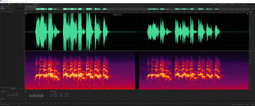
32-bit float in software
Now that we have defined a few concepts, we can talk about 32-bit float. The first time I became aware of it was probably a decade ago. I use Adobe Audition for a lot of my studio work, and most of this happens in waveform mode. Without going into a lot of detail, I do a lot of processing operations in a linear fashion rather than using multitrack mode. This means that once I make a decision, it is difficult to go back from it and all the processing I perform gets burned into the new audio file I’m creating.
As you would expect, I normally keep an eye on levels and try not to let the waveform go above 0dB full scale. At one point during the last decade or so I inadvertently missed this and ended up with audio that seemed cut off by the 0dB limit. Instead of backtracking a number of steps, I simply normalised down to 0dB and was able to recover all that clipped audio without any of the distortion I was expecting.
This is because internally, Adobe Audition always works in 32 bit, even if the file you’re opening is 8, 16 or 24-bit (although as soon as you export from Audition you have to decide what bit depth you will require). This has been around for a long time and it is a very useful workflow. Other software does it too, although some very important ones aren’t there yet. This can create all kinds of compatibility issues that we will get to shortly.
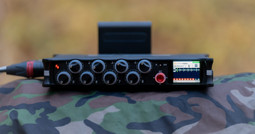
32-bit float in hardware
For the purposes of this article we are only going to talk about field recording equipment. Studio kit is a totally different beast and I will leave this for somebody more qualified.
The first 32-bit field recording device was probably the Zoom F6, although Sound Devices announced their second generation Mixpres before the F6 hit the market. Since then, both Zoom and Sound Devices have released more 32-bit recorders, and they have been joined by Tascam, Tentacle Sync and others.
One of my favourite tools to capture nature and wildlife recordings is the Zoom F3. It’s small, compact and energy-efficient. It does an excellent job in drop rigs, but it does not offer a 24-bit option.
One thing to note here is the implementation of 32-bit. In most devices currently on the market, this relies on two or more Analog-to-Digital converters rather than just one. One of these converters deals with soft sounds, and the other one handles loud ones. Manufacturers aren’t very clear about their ADC and how/when the switch happens. Sound Devices mentions that they use multiple AD converters but not the actual number. Why this is important will become apparent shortly.
Advantages of 32-bit float recording
Being able to record without clipping is the big thing that manufacturers like to bring up. Over the years I’ve had quite a few situations where I set up drop rigs without having any idea about how loud the soundscape would get. Imagine recording a subtle summer atmosphere in a quiet Northern forest, and hours later a thunderstorm approaches. With my F3 I was able to capture great recordings of insect choruses and distant birds, and excellent thunder and rain sounds as well, in the same session. The latter were above 0dbFS, but in post it was a matter of simply normalising to a value below 0dBFS without any loss of quality.
Similarly, I once had a rig stolen and half destroyed by a honey badger in Zambia. I found it more than a hundred yards from where I had set it up. The honey badger had become disinterested in my recorder bag when it realised there’s no food in it, and the mics ended up very close to a tree where an African fish eagle was hanging out. I got a good recording of said eagle this way, but it was clipped. By now you know where this is going. Since I was working with the Zoom F3, it was only a matter of normalising to just under 0dBFS and everything sounded great!
The implementation of 32-bit float on the F3 is such that there is no way to set the gain. This was a strong selling point when the device was released, and I can understand why certain users might find this exciting. It’s one less thing to consider when you’re recording, and it frees up some mental bandwidth for other tasks. Other recorders allow you to set the gain, but remove the limiters which would not make much sense in 32-bit anyway.
That’s about it. I don’t see any other advantage over 24-bit recording. Maybe since 24-bit has been around since last century, 32-bit looks like shiny new tech in comparison. I don’t need to tell you that lots of people tend to buy things just because they’re new.
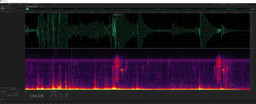
Disadvantages of 32-bit float recording
Let’s look at this claim that there is no clipping when you’re recording in 32-bit float. While true, this is not 100% accurate. I’ve seen an error on my Zoom F3 screen telling me the input is too loud, even for 32-bit float recording. So while 99% of possible uses are covered, this is not valid for all of them.
Clipping can also happen at other stages in the signal path. A loud enough sound can distort at the mic level, especially if you’re using a very sensitive microphone. If preamplification happens before the A/D converter, this is also an area where clipping can take place. 32-bit float simply moves this issue from the ADC to the post stage. Eventually, you will still have to deal with this by using amplification, compression and/or limiting.
Another drawback of the way 32-bit float recording is implemented is sudden bursts of ultrasonic noise that get injected into the file when there is a switch between a/d converters. This used to be more serious when the first recorders were released, and it has been fixed to some extent but not completely. It is an artifact of using more than one analog to digital converter and I’m not sure there is a way to get rid of it. The good news is that this noise happens high in the frequency spectrum, which means for most uses it’s not a huge issue. For sound designers and other professionals who will process these recordings, it means that these bursts of noise might end up in the audible spectrum and will definitely muddy the resulting audio.
FWIW, this doesn’t happen a lot to me. I’ve only seen it a few times in my recordings and it’s never been a critical issue. Nevertheless, it’s worth keeping in mind when choosing a recorder or what mode to record in.
Yet another thing that is often mentioned with regard to 32-bit float recording is the resulting file size. Storage prices are going down, hard drive and solid state drive sizes are going up, but an increase of ⅓ in recorded file size is not negligible. It has not been an issue for me but I have worse problems to think about (storing 4k footage for example). It does get worse with drop rigs and long sessions though.
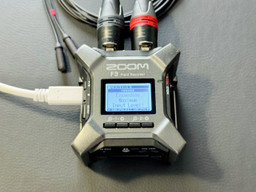
One less mentioned downside is the extra power that is required, both when recording and when opening up and playing back the recordings. When recording for a few days at a time, even an increase of 10-20% in power consumption makes a big difference. I would prefer to have the option to record in 24 bit on the F3 as this would give me more recording time. Similarly, more processing power is required both in the field when recording and in the studio when opening and playing back the files.
Something that is more important than capabilities of specific devices is understanding how they work and knowing how (and when) to use them. Proper gain staging (mentioned above) is a skill that sound recordists need to develop, even if more devices start supporting 32-bit float recording. Unfortunately that will be difficult for a beginner who picks up a Zoom F3. There’s only so much you can learn from others, especially in field recording which is not mainstream enough to be taught in academic environments yet. A lot of my work over the years has been trial and error, and learning from my mistakes. If your device does not offer control over this very important aspect, it will be more difficult to understand and learn to do it properly.
Another downside, that stems from not understanding digital audio well, is sound recordists recording and delivering files in 32-bit. In the case of sound effects libraries, this results in unnecessarily bloated files that need extra work once you have purchased them, and introduce other issues for the end user: do you simply normalise everything down to 0dBFS? What if the dynamic range is very wide? Do you use compression or limiting? This can result in uneven sounding audio and is highly dependant on the compressor settings you decide to use.
If you’re working with sound or video editors, delivering 32-bit audio files can create issues for them. Not all software can deal with this, even though they are catching up. Regardless, consumers who want to listen to music or watch media will need a narrower dynamic range, otherwise they have to ride the volume on their devices constantly. Compression, limiting and conversion to lower bit rates still need to happen, and the recordist has just kicked the can down the road instead of getting the job done properly in the field.
As you can see, there are plenty of downsides for all the advantages I mentioned above. Does this mean 32-bit float is destined to fail? Not exactly.
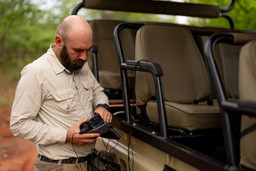
Hardware choices
My recorder collection is fairly large and diversified: 1x SD 633, 4x SD Mixpre II, 6x Zoom F3, 2x Zoom F6, 1x Zoom F8n Pro, and more than 15 Sony recorders (A10, D10, D100). I’ve never purchased a recorder just because it offers 32-bit float recording though. There are more important aspects to consider as you can read below.
For instance the Zoom F6 is much more power-efficient than SD Mixpre 2nd gen devices. On the other hand, Mixpre II recorders have slightly quieter preamps and better performing limiters (although they’re far from the quality of SD 6 or 8 series recorders). If I want absolute quality and reliability, the SD 633 (or its newer sibling, the 833) is the obvious choice. For the most compact rig with the smallest footprint, nothing beats the Sony PCM A10, although the Zoom F3 allows the use of phantom-powered mics while keeping size small as well.
What I’m trying to say here is that no piece of kit is perfect, and everything is a sum of its advantages and disadvantages. If you know your kit well enough, you can make the right choice, and 32-bit float recording is simply a tool that can be useful in certain situations.
It is not the most crucial thing, and definitely not as important as the manufacturers are trying to make it seem. 32-bit float has become a bit of a buzzword, and if you don’t know the basics of digital audio you might be swayed by shiny marketing. Do your homework, go out in the field and record as much as you can, bring your recordings home and listen to them carefully, and you will slowly learn to see beyond the hype.

All photos courtesy of George Vlad
Earth.fm is a completely free streaming service of 1000+ nature sounds from around the world, offering natural soundscapes and guided meditations for people who wish to listen to nature, relax, and become more connected. Launched in 2022, Earth.fm is a non-profit and a 1% for the Planet Environmental Partner.
Check out our recordings of nature ambience from sound recordists and artists spanning the globe, our thematic playlists of immersive soundscapes and our Wind Is the Original Radio podcast.
You can join the Earth.fm family by signing up for our newsletter of weekly inspiration for your precious ears, or become a member to enjoy the extra Earth.fm features and goodies and support us on our mission.
Subscription fees contribute to growing our library of authentic nature sounds, research into topics like noise pollution and the connection between nature and mental wellbeing, as well as funding grants that support emerging nature sound recordists from underprivileged communities.
